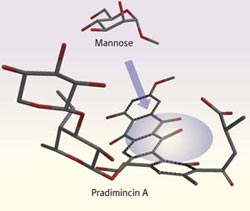Unpicking HIV’s invisibility cloak

Figure 1: The compound pradimicin A disrupts the human immunodeficiency virus (HIV) by clinging to its mannose-rich coat. The mannose sits within a cavity in the pradimicin A structure (purple shading). Copyright : 2012 Yu Nakagawa<br>
Drug researchers hunting for alternative ways to treat human immunodeficiency virus (HIV) infections may soon have a novel target—its camouflage coat. HIV hides inside a cloak unusually rich in a sugar called mannose, which it uses to slip past the immune system before infecting its host’s cells.
Recently, however, biochemists discovered a family of chemical compounds that stick strongly to mannose. Understanding how this mechanism works could reveal a way to make drugs adhere to and kill HIV. Yu Nakagawa and Yukishige Ito at the RIKEN Advanced Science Institute in Wako and their colleagues from several research institutes in Japan are leading the effort: they have mapped the binding site of the mannose-binding compound pradimicin A1.
Mannose-binding compounds are particularly attractive to drug researchers thanks to their double-action anti-HIV effect. By sticking to mannose in the virus’s coat, pradimicin A first freezes HIV’s molecular machinery for entering and infecting its host’s healthy cells. The virus responds by reducing the mannose in its coat thereby revealing itself to the immune system, which can then attack.
Unraveling just how pradimicin A recognizes mannose, however, has proven surprisingly difficult. In solution, the two components stick together in variously sized small clusters, confounding conventional analytical techniques such as solution-based nuclear magnetic resonance (NMR) and x-ray crystallography. Nakagawa, Ito and their colleagues side-stepped the clumping problem by using solid-state NMR, which allowed them analyze the compounds as solids, rather than in solution.
The research team’s approach involved inserting carbon-13, a chemical label, into particular parts of the pradimicin A structure. Carbon-13 boosts the NMR signal wherever it is inserted, so the team could ‘walk’ around the compound and detect where it interacts most strongly with mannose.
The results revealed that pradimicin A curls up to form a cavity, within which the mannose structure sits (Fig. 1). “Our study highlights the benefit of solid-state NMR methodology to investigate this interaction,” says Nakagawa. “Solid-state NMR is, at present, the only technique to analyze such a complicated system.” Flagging the potential utility of the technique, Nakagawa adds that: “Our analytical strategy might be applicable to other systems that similarly suffer from aggregation in solution.”
Meanwhile, solid-state NMR can offer even more in probing mannose–pradimicin A binding, Nakagawa says. Having determined how and where pradimicin A grabs mannose, the team’s next step will be to use the technique to identify the specific molecular interactions that bind the pradmicin A to this potential Achilles' heel of HIV.
The corresponding author for this highlight is based at the Synthetic Cellular Chemistry Laboratory, RIKEN Advanced Science Institute
Media Contact
All latest news from the category: Life Sciences and Chemistry
Articles and reports from the Life Sciences and chemistry area deal with applied and basic research into modern biology, chemistry and human medicine.
Valuable information can be found on a range of life sciences fields including bacteriology, biochemistry, bionics, bioinformatics, biophysics, biotechnology, genetics, geobotany, human biology, marine biology, microbiology, molecular biology, cellular biology, zoology, bioinorganic chemistry, microchemistry and environmental chemistry.
Newest articles

High-energy-density aqueous battery based on halogen multi-electron transfer
Traditional non-aqueous lithium-ion batteries have a high energy density, but their safety is compromised due to the flammable organic electrolytes they utilize. Aqueous batteries use water as the solvent for…

First-ever combined heart pump and pig kidney transplant
…gives new hope to patient with terminal illness. Surgeons at NYU Langone Health performed the first-ever combined mechanical heart pump and gene-edited pig kidney transplant surgery in a 54-year-old woman…

Biophysics: Testing how well biomarkers work
LMU researchers have developed a method to determine how reliably target proteins can be labeled using super-resolution fluorescence microscopy. Modern microscopy techniques make it possible to examine the inner workings…





















